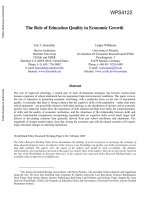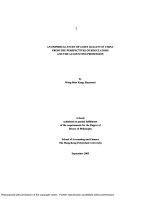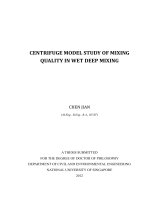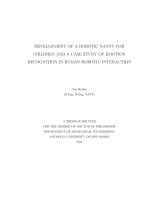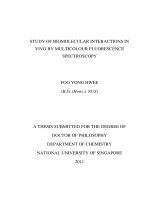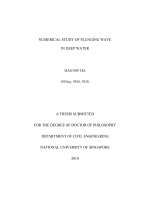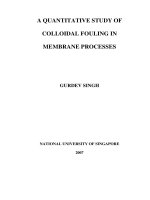Centrifuge model study of mixing quality in wet deep mixing
Bạn đang xem bản rút gọn của tài liệu. Xem và tải ngay bản đầy đủ của tài liệu tại đây (9.82 MB, 338 trang )
TITLEPAGE
CENTRIFUGEMODELSTUDYOFMIXING
QUALITYINWETDEEPMIXING
CHENJIAN
(M.Eng., B.Eng., B.A., HUST)
A THESIS SUBMITTED
FOR THE DEGREE OF DOCTOR OF PHILOSOPHY
DEPARTMENT OF CIVIL AND ENVIRONMENTAL ENGINEERING
NATIONAL UNIVERSITY OF SINGAPORE
2012
-ii-
iii
Dedicated to my families
-iv-
DECLARATION
I hereby declare that the thesis
is
my
original work and
it
has been written by
me
in
its
entirety. I have duly acknowledged all the sources
of
information which have been
used
in
the thesis.
This thes
is
has also not been submitted for any degree
in
any university previously.
v
-vi-
vii
ACKNOLEDGEMENTS
First and foremost, I would like to express my sincerest gratitude and appreciation to
my supervisor, Professor Lee Fook Hou, who has supported me with his valuable,
patient and endless guidance throughout my Ph.D study. He does not only teach me
with knowledge but also how to face difficulties in both research work and daily life.
I attribute the level of my doctor’s degree to Prof. Lee’s encouragement and effort and
without him, this thesis, too, would not have been able to be completed. The
philosophy I learned from Prof. Lee during the past five years will be priceless
fortune of mine and influence my career in a life time.
During my Ph.D study, I have been aided a lot by the technical and professional staffs
in NUS Centrifuge and Geotechnical Laboratory. I would like to thank Mr. Tan Lye
Heng, Mr. Wong Chew Yuen, Dr. Shen Ruifu and Mr Loo Leong Huat for their
precious help and constructive comments for my centrifuge testing. Moreover,
acknowledgements should also be given to Mr. John Choy, Ms. Jamilah, Mr. Foo Hee
Ann, Mr. Sit Beng Chiat, Ms. Lee Leng Leng, Mr. Yong Tat Fah, Mr. Ang Beng Oon,
Ms. Sandra Martin and Mr. Shaja Khan. Special acknowledgement should also be
given to Assistant Professor, Dr. Goh Siang Huat, who gave me helpful comments on
my research and paper writing.
Moreover, I am also grateful to my fellow colleagues, my seniors and juniors. They
-viii-
are Assistant Professor Cheng Yonggang, Dr. Yeo Chong Hun, Dr. Xiao Huawen, Dr.
Yi Jiangtao, Mr. Zhao Ben, Mr. Liu Yong, Ms. Li Yuping, Mr. Yang Yu, Mr. Zhang Lei.
Special thank is given to Mr. Liu Yong. He undertook the part of numerical
simulation in this project of deep mixing method. And the constructive discussions
and collaboration between us promoted the completion of this thesis.
Moreover, I acknowledge the financial support by Research Scholarship Programme
from the National University of Singapore. Without this financial support, I could
not accomplish this study.
Finally, I would like to express the most grateful acknowledgements to my families,
my wife, daughter and parents, who gave me endless support and encouragement to
complete my research and writing up.
ix
TABLE OFCONTENTS
TITLEPAGE i
ACKNOLEDGEMENTS vii
TAB L E OFCONTENTS ix
SUMMARY xv
LISTOFTABLES xvii
LISTOFFITURES xix
LISTOFSYMBOLS xxxvii
Chapter1 Introduction 1
1.1 Background on ground improvement 1
1.2 Deep Mixing Method 1
1.3 Mixing process of DMM 3
1.4 Objectives and significance of this study 5
1.4.1. Scope and objectives 5
1.4.2. Significance of this study 6
1.5 Structure of the thesis 8
Chapter2 LiteratureReview 15
2.1. Introduction to literature review 15
2.2. Field tests for DMM 15
2.3. Physical modelling 19
2.3.1. 1-g modelling 19
-x-
2.3.2. Centrifuge modelling 22
2.4. Quality assessment and control for DM columns 26
2.4.1. Mixing uniformity 26
2.4.2. Influencing factors to deep mixing quality 31
2.4.3. Quality control and assurance 34
2.5. Mixing process and tools for DMM 34
2.6. Probabilistic and statistical methods in DM studies 39
2.6.1. Statistical methods in lab and field testing 39
2.6.2. Studies on autocorrelation 42
2.7. Empirical strength functions of stabilized soil 44
2.8. Limitations of the previous studies 48
2.8.1. Field testing and physical modelling 49
2.8.2. Influencing factors to the mixing uniformity 50
Chapter3 ExperimentalSetupandProcedures 79
3.1. Introduction to experimental work 79
3.2. Centrifuge model 79
3.2.1. Model container 79
3.2.2. Model DM installers 80
3.2.3. Model binder 81
3.2.4. Design of single-shaft DM system 82
3.2.5. Design of multi-shaft deep mixer 82
xi
3.3. Scaling relations 83
3.4. Test preparations 84
3.4.1. Preparation of the model soil bed 84
3.4.2. Assembly of the DM model system 85
3.4.3. Determination of the binder density 85
3.4.4. Control and monitoring of the soil properties 86
3.5. Deep mixing process 87
3.6. Post-processing of the tests 87
3.6.1. Sampling procedure 87
3.6.2. Chemical analysis 88
3.7. Summary of this chapter 90
Chapter4 InfluencingFactorstoMixingUniformity 111
4.1. Test series for parametric study 111
4.2. Effect of Blade Rotation Number 112
4.3. Effect of Over-Consolidation Ratio (OCR) 114
4.4. Effect of blade angle 116
4.5. Effect of binder density 117
4.6. Effect of mixing rotational speed 118
4.7. Effect of radial distance and soil depth 119
4.8. Effect of multi-shaft deep mixing 120
4.9. Examination of autocorrelation 121
-xii-
4.10. Summary of this chapter 124
Chapter5 A Statistical Model for Strength Prediction of the
DMColumns151
5.1. Introduction 151
5.2. Distribution of binder concentration 151
5.2.1. Characteristics of chloride distribution 152
5.3. Selection of the strength function 156
5.4. Phase Relationships 159
5.4.1. Chloride concentration and binder density 159
5.4.2. Chloride concentration and binder concentration 160
5.4.3. Components in prototype DM columns 161
5.5. Development of statistical model 163
5.5.1. Distributions of C, X and Y 163
5.5.2. Probability distribution of UC strength in a DM column 166
5.5.3. Relationship between PDFs of r and h 167
5.6. A Problem with Lee et al.’s (2005) Relationship 168
5.7. Input Statistical Parameters 170
5.7.1. Coefficient of variation 170
5.7.2. Mean chloride ion concentration 170
5.8. Summary of this chapter 171
Chapter6 ComparisonofStatisticalModelwithFieldData201
xiii
6.1. Introduction for case studies 201
6.2. Overview of Ground Improvement Works 201
6.3. Design and Operating Parameters 203
6.4. In-situ Soil Conditions 204
6.5. Application of the Statistical Model 205
6.6. Comparison of Model Results and Field Data 206
6.7. Comparison with Mizuno et al.’s Field Data 209
6.8. Summary of this chapter 210
Chapter7 ConclusionsandRecommendations 233
7.1. Summary of Findings and Contributions 233
7.2. Significant findings 235
7.3. Recommendations for future work 236
References 237
AppendixA. Spot binder concentrations for all model
columns 257
AppendixB. Relevantpublications 297
-xiv-
xv
SUMMARY
Deep Mixing Method (DMM) is widely used for in-situ soil treatment which involves
mixing stabilizers (usually cement) with weak clayey soil. The uniformity of the
strength distribution of DM columns depends on the degree of mixing in the DM
installation process. However, due to the lack of research on the mixing process, the
highly variable strength of the DMM improved soil, which indicates poor mixing
quality, remains a problem in construction. Larsson (2003) theoretically analyzed the
mechanism of the mixing process and studied the uniformity of binder distribution for
dry DMM by field tests. Lee et al. (2006; 2008) and Lee (2006) studied the feasibility
of using centrifuge to model the wet DM process and initiated the parametric studies on
various factors affecting the uniformity of the mixing.
In this study, a new centrifuge model, which can be used to simulate the in-flight deep
mixing process of both single and multi-shaft, was developed. Moreover, a
post-processing procedure for faster sample measuring was proposed. Based on a
series of centrifuge model tests for DMM, a detailed parametric study on the various
factors affecting deep mixing quality has been carried out. The factors include:
blade rotation number, over-consolidation ratio, blade angle, binder density, mixing
rotational speed, radial distance, soil depth and multi-shaft mixing. Besides these
factors, the autocorrelation structure in radial distance within the DM column has also
been examined. Some conclusions have been drawn about the different significance
-xvi-
levels, in which those factors influence the mixing quality.
Based on the considerable amount of test samples and relevant statistical analysis, the
binder concentration variation was examined and proved to be well-fitted by a
truncated normal distribution. The phase relationships within the DM column were
theoretically established. Based on the empirical relationship of unconfined
compressive strength (UCS), soil cement ratio and water cement ratio proposed by Lee
et al. (2005) and the phase relationships, a statistical model for the UCS prediction of
DM columns had been derived from the distribution of binder concentration. This
proposed statistical model will allow engineers and research a first-cut estimation of
the mean, COV and the PDF of the UCS of the DM columns, during design and
construction of DM, even before field trials are undertaken.
Field core strength sample data from Marina Bay Financial Centre project was
compared and analyzed with the prediction of the statistical model. The comparison
results shows that the statistical model reasonably fits the histograms of the field UCS
with a rational selection of the model coefficients, m and n, which comes from Lee et
al.’s (2005) empirical formula.
xvii
LISTOFTA BLES
Table 1.1 Terminology of the DM family (After Porbaha 1998) 9
Table 1.2 Development of deep mixing method (From Terashi and Juran 2000) 9
Table 2.1 Factors affecting the strength increase (After Terashi 1997) 53
Table 3.1 Scaling implications of centrifuge model tests (After Lee et al. 2008) 93
Table 3.2 Physical properties of Kaolin Clay (After Ong 2004) 93
Table 3.3 Operating parameters in some reported deep cement mixing projects
(From Lee 2006) 94
Table 4.1. Operational parameters of all tests for Single-Shaft DM System 127
Table 4.2. Operational parameters of all Tests for Multi-Shaft DM System 129
Table 4.3 Test series for effect of OCR 130
Table 4.4 Test series for effect of blade angle 130
Table 4.5 Comparisons between single-shaft and multi-shaft tests 131
Table 4.6 Test series for autocorrelation 131
Table 5.1 Parameters used in centrifuge model tests from Lee (2006) 173
Table 5.2 Linearity of the probability tests for test groups on different distributions
for samples from Lee (2006) 173
Table 5.3 Linearity of the probability tests for test groups on different distributions
for samples from current model tests 174
Table 5.4 Comparison of the p-values for the probability tests with linearity 175
Table 6.1 DM based on proposed improvement layer for 4-shafts construction 211
-xviii-
xix
LISTOFFITURES
Figure 1.1 Marine operation of DMM in Tokyo Bay (Terashi and Juran 2000) 11
Figure 1.2 Equipment for DMM 12
Figure 1.3 DMM in Singapore 13
Figure 1.4 Typical mixing tools for wet DMM (Taki and Bell 1998a; Yoshida 1996)
13
Figure 1.5 Structure of this thesis 14
Figure 2.1 Change of (a) water content and (b) density by in-situ quicklime
treatment (Kamata and Akutsu 1976) 55
Figure 2.2 Change of water content by in-situ cement treatment (Kawasaki et al.
1978) 55
Figure 2.3 Change of density by in-situ cement treatment (Japan Cement
Association 1994) 55
Figure 2.4 Poisson ratio of in-situ cement treated soil (Hirade et al. 1995; Niina et al.
1977) 56
Figure 2.5 Stress-strain of in-situ treated soil (Sugiyama et al. 1980) 56
Figure 2.6 Long-term strength of in-situ treated soils (Terashi and Kitazume 1992)
56
Figure 2.7 Relationship between unconfined compressive strength of laboratory
treated soil and of in-situ treated soil: (a) land construction (Public Works Research
Center 1999) (b) marine construction (Noto et al. 1983) 57
-xx-
Figure 2.8 (a) Arrangement of columns and sampling positions (b) Core sampling
(Yoshida 1996) 57
Figure 2.9 Prototype auger and installed test DM columns (Al-Tabbaa et al. 1998) 58
Figure 2.10 (a) Double mixing machine (b) model equipment (Horpibulsuk et al.
2004) 58
Figure 2.11 (A) Mixing tool employed in the field; (B) Cement stabilized specimen
mixed in lab and field (Van Impe and Verastegui Flores 2006) 58
Figure 2.12 (A) 1-g model for in-situ mixing (B) types of mixing blades (Dong et al.
1996) 59
Figure 2.13 (a) Model setup (b) typical failure pattern (Kitazume et al. 1996b) 59
Figure 2.14 (a) Model mixing machine (b) sampling location (Matsuo et al. 1996) 60
Figure 2.15 Model column making device (a, b) and installed model column (c)
(Shen and Saga Daigaku. 1998) 60
Figure 2.16 Prototype and modelled DM system by Al-Tabbaa et al. (1999) 61
Figure 2.17 Schematic of the installation of model DM columns (Kosche 2004) 61
Figure 2.18 Testing surface of the model DM column after 14 days (Kosche 2004)
62
Figure 2.19 (a) Model test system for embankment loading (b) for lateral loading (c)
numerical simulation (Miyake et al. 1991) 62
Figure 2.20 Centrifugal model test results on the stability of revetment during sea
reclamation behind the caisson (Kitazume 1991) 63
xxi
Figure 2.21 Typical failure patterns observed in centrifuge tests (Kitazume et al.
1996a; Kitazume and Maruyama 2007a) 63
Figure 2.22 (a) Centrifuge model for DM retaining wall, (b) reinforcement ratio of
0.08%, (c) reinforcement ratio of 0.4% (Babasaki and Suzuki 1998) 64
Figure 2.23 Plan and side view of the in-situ retaining wall tests (Babasaki and
Suzuki 1998) 65
Figure 2.24 (a) Model ground (b) deformation of the DM treated ground subjected
to embankment loading (Hashizume et al. 1998) 65
Figure 2.25 Centrifugal test devices for the single and the group piles (Kimura and
Matsuura 2002) 66
Figure 2.26 Setup of the centrifuge model for DMM (Lee 2006; Lee et al. 2008) 66
Figure 2.27 Variation of Average Strength and COV of Treated Soil with slurry w/c
(Yoshizawa et al. 1997) 66
Figure 2.28 Coefficient of variation evaluated from compression tests in a number
of reported studies (Larsson 2003) 67
Figure 2.29 Test levels and cross-section of DM column for different sample sizes
(Larsson 2001) 67
Figure 2.30 Area ratios for various locations (Larsson 2001) 67
Figure 2.31 Variation of COV at difference model withdrawal rate (DM installer A:
single twisted-blades inclined at 45°, DM installer B: twisted-blades inclined at 45°
arranged in double layers) (Lee 2006) 68
-xxii-
Figure 2.32 Mean concentration and COV for all depth within the DM column for
high-g and 1-g model tests at different slurry density of 1.3g/cm
3
, 1.5g/cm
3
and
1.7g.cm
3
(Lee 2006) 68
Figure 2.33 Coefficient of variation within DM column for 50g centrifuge and 1g
model tests at different slurry densities of 1.7 g/cm
3
, 1.5 g/cm
3
and 1.3 g/cm
3
(Lee et
al. 2006) 69
Figure 2.34 Comparison of strength achieved using 1-shaft and 4-shaft model
mixers (Nishibayashi et al. 1985) 69
Figure 2.35 Open-type mixing blade (Abe et al. 1997) 70
Figure 2.36 Comparison of quality with and without free blade (Enami et al. 1985)
70
Figure 2.37 Influence of rotation speed of mixing blade (Nishibayashi et al. 1985) 71
Figure 2.38 Influence of penetration speed of mixing shaft (Enami et al. 1986) 71
Figure 2.39 Relationship between the blade rotation number and strength of in-situ
treated soil (Mizuno et al. 1988a) 71
Figure 2.40 Flow chart for quality control and quality assurance (CDIT (Coastal
Development Institute of Technology) 2002) 72
Figure 2.41 (a) Non-random and (b) random mixture; (c) a typical correlation
coefficient for a random mixture (1994) 72
Figure 2.42 (a) Decreases in the length scale (S) and intensity of segregation (l)
improve the quality of a mixture; (b) the effect of changes in sample size on the length
xxiii
scale (S) and intensity of segregation (l) on the quality of a mixture (1994) 72
Figure 2.43 Recommended viscosity ranges for some common types of impeller
(Niranjan et al. 1994) 73
Figure 2.44 Decision chart for the selection of solids mixing equipment (Niranjan et
al. 1994) 73
Figure 2.45 Tangential, radial and axial flow (Sterbacek and Tausk 1965) 74
Figure 2.46 Radial propeller mixer (Sterbacek and Tausk 1965) 74
Figure 2.47 Typical propellers, turbines and paddles (King 1992) 74
Figure 2.48 Mixing blades of DM machines for on-land work (CDIT (Coastal
Development Institute of Technology) 2002) 75
Figure 2.49 Relation between
f
qu
and F
c
(Saitoh et al. 1996) 75
Figure 2.50 Coefficient of variation, V, as a function of quotient between water
content and liquid limit multiplied by logarithm of blade rotation number, w/w
l
×
log(T) (Larsson et al. 2005b) 75
Figure 2.51 Examples of evaluated experimental semi-variograms (Larsson et al.
2005c) 76
Figure 2.52 Strength distribution for laboratory testing and in-situ DM columns
(CDIT (Coastal Development Institute of Technology) 2002) 76
Figure 2.53 Autocorrelation of undrained shear strength in vertical direction
(Matsuo and Asaoka 1977) 76
Figure 2.54 Fitness to normal distribution (Honjo 1982) 77
-xxiv-
Figure 2.55 Calculation of auto-correlation function of the in-situ stabilized ground
for different sites (Honjo 1982) 77
Figure 3.1 Orthographic Views and dimensions of the model container 95
Figure 3.2 Schematic of in-flight DM cutting and mixing equipment (From Lee et al.
2006) 95
Figure 3.3 DM installer A, blade angle of (a) 45° and (b) 90° 96
Figure 3.4 DM installer B, blade angle of (a) 45° and (b) 90° 97
Figure 3.5 DM installer C 98
Figure 3.6 Some of the model DM installers, from the left to the right, C, B & A 98
Figure 3.7 Design of the Sauer-Danfoss miniature hydraulic motor (Sauer-Danfoss
2009) 99
Figure 3.8 Performance graph for the miniature hydraulic motor (Sauer-Danfoss
2009) 99
Figure 3.9 The single-shaft DM model system 100
Figure 3.10 Design drawings for multi-shaft DM model system 100
Figure 3.11 The multi-shaft DM model system 101
Figure 3.12 Kaolin powder used in the model tests 101
Figure 3.13 Clay mixer and de-airing chamber 101
Figure 3.14 Design of the whole system 102
Figure 3.15 Assembly of the whole system 103
Figure 3.16 Setup of the model system on the NUS centrifuge platform before test
xxv
103
Figure 3.17 Typical T-bar profile for model soil 104
Figure 3.18 Pepperl & Fuchs - ML5-6/30/115 photoelectric sensor and Tachometer
104
Figure 3.19 Model installer C installed at the tip of the rotational shaft 104
Figure 3.20 Installed DM column 105
Figure 3.21 Sampling 105
Figure 3.22 Sampling bottles 105
Figure 3.23 Sample collections 106
Figure 3.24 Layout of the sample locations and the Area Ratio for single-shaft and
multi-shaft 106
Figure 3.25 Measuring tubes for chloride ion 107
Figure 3.26 EUTECH pH/Ion meter (CyberScan pH2100) 107
Figure 3.27 DIONEX Ion Chromatograph 107
Figure 3.28 Calibration of the Ion Meter (example plot) 108
Figure 3.29 Measurement validation by IC (example plot) 108
Figure 3.30 Test flowchart 109
Figure 4.1 Mean binder concentration versus blade rotation number for all
single-shaft mixed columns 133
Figure 4.2 Binder COV versus blade rotation number for all single-shaft mixed
columns 133

